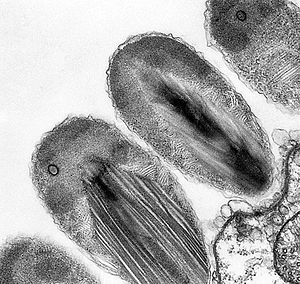Epixenosoma
| Candidatus Epixenosoma | ||||||
|---|---|---|---|---|---|---|

Transmission electron microscope image of a Stage II epixenosome |
||||||
| Systematics | ||||||
|
||||||
| Scientific name | ||||||
| Candidatus Epixenosoma ' | ||||||
| Oren et al. 2015 | ||||||
| species | ||||||
|
Epixenosoma , scientifically referred to as Candidatus Epixenosoma , is a genus of bacteria in the phylum Verrucomicrobia that form a symbiosis with marine ciliates (Ciliophora) of the genus Euplotidium , where they help defend their ciliate hosts against predators. The genus is monotypical ; H. it only contains the species Ca. Epixenosoma ejectans .
description
Epixenosomes have two different developmental phases that are associated with the host cell cycle. Level I epixenosomes are spherical, 0.5 µm in diameter and surrounded by two membranes. They divide by direct binary division. Stage II epixenosomes are egg-shaped (2.2 μm long and 1 μm wide) and exhibit a complex organization with various cytoplasmic compartments that are more complicated than the majority of prokaryotic organisms. They contain an extrusible apparatus within a protein-containing matrix, which, however, is apparently not bound to the membrane, which differs from the rest of the cytoplasm . Functional cell compartmentalization was also demonstrated.
Systematics
Its phylogenetic position was originally unclear as it appeared to have both prokaryote-like features such as binary cleavage and eukaryote- like features such as intracellular membranes. However, molecular phylogenetics showed that they are actually bacteria from the phylum Verrucomicrobia.
Symbiosis for the purpose of defensive symbiosis of Euplotidium
Epixenosomes live on the dorsal surface of their hosts ( dorsal ), marine ciliates (Ciliophora) of the genus Euplotidium . The name “Epixenosoma” comes from the ancient Greek επι ξενον σομα and means “external foreign body”, which indicates its extracellular position on the host. The axtrusions expel their contents when triggered; this process helps defend the ciliates against predators. Although euplotidium can grow and reproduce without epixenosomes, those with epixenosomes have a much higher survival rate when exposed to predators like litonotus (also a ciliate).
External signals of unknown origin are detected by the membrane receptors on top of the organism. The consequent activation of the adenylate cyclase - cAMP system triggers the ejection of the extrusion apparatus, forming an approximately 40 μm long hollow tube that ends in a head consisting mainly of the apical part of the epixenosome (the region that contains DNA) .
The extrusion device is surrounded by a basket of tubules (microtubules). Experiments with antitubulin drugs and immunocytochemical analyzes at the optical and electron microscopic level suggest that these tubules are made of tubulin , a eukaryotic protein. Although tubulin genes have also been found in some free-living Verrucomicrobia , no tubular structures such as those of epixenosomes have been found.
Individual evidence
- ↑ a b c d G. Rosati: Epixenosomes: symbionts of the hypotrich ciliate Euplotidium itoi . In: Symbiosis . 26, 1999, pp. 1-23.
- ↑ Giulio Petroni, Stefan Spring, Karl-Heinz Schleifer, Franco Verni, Giovanna Rosati: Defensive extrusive ectosymbionts of Euplotidium (Ciliophora) that contain microtubule-like structures are bacteria related to Verrucomicrobia . In: Proceedings of the National Academy of Sciences . 97, No. 4, February 15, 2000, ISSN 0027-8424 , pp. 1813-1817. doi : 10.1073 / pnas.030438197 . PMID 10660683 . PMC 26518 (free full text).
- ↑ Giovanna Rosati, Giulio Petroni, Silvia Quochi, Letizia Modeo, Franco Verni: Epixenosomes: Peculiar Epibionts of the Hypotrich Ciliate Euplotidium Itoi Defend Their Host Against Predators . In: Journal of Eukaryotic Microbiology . 46, No. 3, May 1, 1999, ISSN 1550-7408 , pp. 278-282. doi : 10.1111 / j.1550-7408.1999.tb05125.x .
- ↑ Cheryl Jenkins, Ram Samudrala, Iain Anderson, Brian P. Hedlund, Giulio Petroni, Natasha Michailova, Nicolas Pinel, Ross Overbeek, Giovanna Rosati: Genes for the cytoskeletal protein tubulin in the bacterial genus Prosthecobacter . In: Proceedings of the National Academy of Sciences of the United States of America . 99, No. 26, December 24, 2002, ISSN 0027-8424 , pp. 17049-17054. doi : 10.1073 / pnas.012516899 . PMID 12486237 . PMC 139267 (free full text).
See also
- Extrusome - organelles in some protists that have a function similar to epixenosomes
- Ectosymbiosis